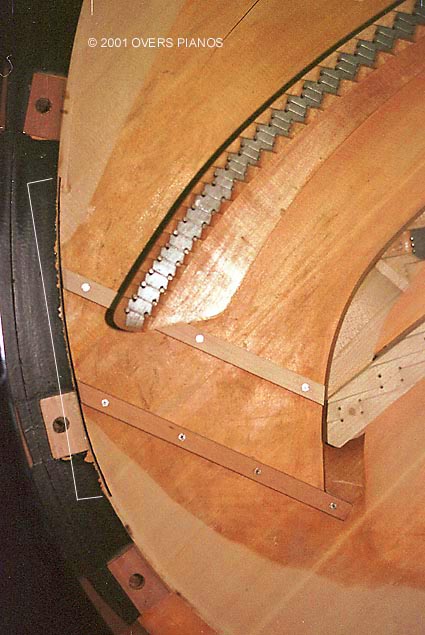YAMAHA G2 WITH SOUND BOARD FLOAT

In recent years, suspended bridges have fallen out of favour (though not yet far enough) with many contempory piano designers.
The sound board float built into this G2 is centered adjacent to note A1. Two auxilliary sound board ribs (16mm wide by 8 mm high) have been attached to the top of the panel, running diagonally from the treble bridge to meet the perimeter of the float, 90 mm in from each end of the float slot (the slot is highlighted on the image by the while bracket), and lying almost perpendicular to the sound board panel grain direction. The auxilliary ribs are itended to encourage the sound board panel immediately under the influence of the lower end of the bass bridge to move more as a unit, since there are no sound board ribs under the sounboard panel in this area. The ribs still allow the float to remain flexible since they meet the float perimeter 90 mm distant from the ends of the slot.
The float slot has been sanded smooth and sealed, with lacquer, to minimise sound board panel moisture transients.
The upper rib, which runs underneath and is glued to the underside of the bridge suspension, is made from hard maple, while the lower is made from King Billy Pine (a local pine from Tasmania, and distantly related to the Californian Redwoods). King Billy Pine (Athrotaxis selaginoides, ADD 0.38-0.4 gr/cc) is the only Australian wood suitable for belly making.
The small grand presents the designer with a dilema in the low bass, regarding the trade off between speaking length, back length and the proximity of the bass bridge to the inner rim of the sound board. Historically, the suspended bridge has been used in smaller pianos (as used originally in this G2) to maximise speaking length while maintaining a workeable bridge/sound-board-contact distance from the sound board perimeter. However, the suspended bridge is a poor second best performer when compared to the option of floating the sound board panel adjacent to the lowest notes on the bass bridge. However, should the desire to increase the speaking length be taken too far for the size of a given instrument, there is a risk of reducing the back length to such an extend that the bridge and sound board will be 'locked up' by the short and stiff backlengths. The net effect of the shorter backlengths might well simulate a stiff bar, holding the sound board panel to prevent it moving sufficiently. It is not surprising therefore, that some of the rediculously short grand pianos out there have a complete lack of fundamental tone in the extreme bass. Not only do some of these instruments have impractically short speaking lengths, but the bass bridge is practically sitting over the inner rim.
The option of using a sound board float would seem to offer several advantages;
HOW DID THE SOUND BOARD FLOAT PERFORM?
The lower bass of the finished piano performed very well indeed (as did the other sections of the piano). The 'rap' test, prior to stringing, gave a positive indication of a very active board in the lower bass. The combination of a revised string scale (the bass single A1 was made from 1.225 mm core wire with a 6.35 mm diameter copper wrap) with the active float allowed the bass of this piano to easily outperform the tonal quality of a typical 6'6" grand piano. This technology will certainly find its way into the Overs 170 grand piano.
TO RETURN TO OVERS' MAIN BROWSER WINDOW, PLEASE CLOSE THIS WINDOW AT THE TOP-LEFT CLOSE BOX
First published 16 March, 2001
Copyright ©
2001, Overs Pianos.